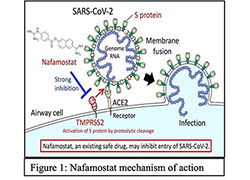25 Feb 2021
Nafamostat for treatment of COVID-19
As COVID-19 is a new disease resulting in an unprecedented global healthcare burden, there have been a very large number of drugs rapidly escalated into clinical trials of treatment effectiveness. In spite of a continual stream of published data, there remains no clear data or consensus for anti-viral drugs in the treatment of COVID-19. Recent data supporting remdesivir, particularly in patients that are not mechanically ventilated, has resulted in it being a recommended COVID-19 therapy in patients requiring supplemental oxygenation by some treatment guidelines (1), but not all (2, 3), given inconsistent results across major trials (4, 5). Despite the pleasing COVID-19 vaccine roll-out occurring globally, it is clear that COVID-19 will persist as a serious disease for some time yet and that drugs with effectiveness against COVID-19 are still urgently required.

Nafamostat mechanism of action
The knowledge that the SARS-CoV-2 virus spike protein S, which mediates its cell entry, depends on a cellular enzyme called transmembrane protease serine 2 (TMPRSS2) has generated interest in TMPRSS2 being an attractive drug target. Nafamostat, a TMPRSS2 inhibitor, blocks SARS-CoV-2 entry into human cells and is much more potent than remdesivir in laboratory experiments (Figure 1; Credit: 2020 The University of Tokyo) (6,7). On this basis, ASCOT has included nafamostat as a treatment intervention. However, outside of Korea and Japan where nafamostat is used as a treatment for acute pancreatitis and some blood clotting conditions, most clinicians have little knowledge or experience with this drug. So what is known about nafamostat?
Nafamostat is highly potent against SARS-CoV-2. Of all drugs with potency data from laboratory studies using human cell lines against SARS-CoV-2, nafamostat appears to be the most potent and may be the only drug where blood concentrations almost always exceed levels required to stop the virus from replicating (7,8). It is also likely that nafamostat will reach high levels in the lungs where the SARS-CoV-2 virus causes so much of its problems.
Nafamostat also has a favourable safety profile. In a report that included 6732 patients, adverse effects were observed in only 1.7% of patients, with liver dysfunction (defined as elevated transaminases) in 0.82% and rash in 0.34%. Increased bleeding was not observed (9). The anti-blood clotting properties of nafamostat (10,11) may be a further potential advantage of this drug as micro clots in the vascular system can be complications of COVID-19 (10).
Nafamostat has been clinically studied in small case series of patients hospitalised with COVID-19 (12,13) and there are few planned randomised controlled trials. A Phase 2 study of nafamostat in more than 100 hospitalised patients in Russia is expected to have results available soon.
In ASCOT, nafamostat stock has been donated by the drug’s manufacturer, Chong Kun Dang Pharmaceuticals. The drug has already been received in Australia and is expected in New Zealand soon. Patients in ASCOT participating in the anti-viral domain will be randomised to receive the usual standard of care (SOC) OR nafamostat plus standard of care for seven days.
References:
- National Institutes of Health, COVID-19 Treatment Guidelines; https://www.covid19treatmentguidelines.nih.gov
- World Health Organisation; Therapeutics and COVID-19: living guideline; https://www.who.int/publications/i/item/therapeutics-and-covid-19-living-guideline
- National COVID-19 Clinical Evidence Taskforce, https://covid19evidence.net.au
- Beigel JH et al., NEJM 2020; 383(19):1813-1826
- WHO Solidarity Trial Consortium, NEJM 2020; doi: 10.1056/NEJMoa2023184
- Beigel JH, et al. NEJM 2020. doi: 10.1056/NEJMoa2007764
- Ko M, et al. J Med Virol 2020. PMID: 32767684
- Yamamoto M, et al. Viruses 2020 Jun 10;12(6):629
- Hoffman M, et al. Cell 2020; 181(2): 271-80
- Nafamostat. Pharmaceuticals and Medical Devices Agency. April 2019 Revision (6th Edition). Available at: http://www.pmda.go.jp/
- McFadyen JD, et al. Circulation Res 2020;127:571–587
- Murase M, et al. Circulation 1993 Nov;88(5 Pt 2):432-6.
- Doi K, et al. Crit Care. 2020;24(1):392


